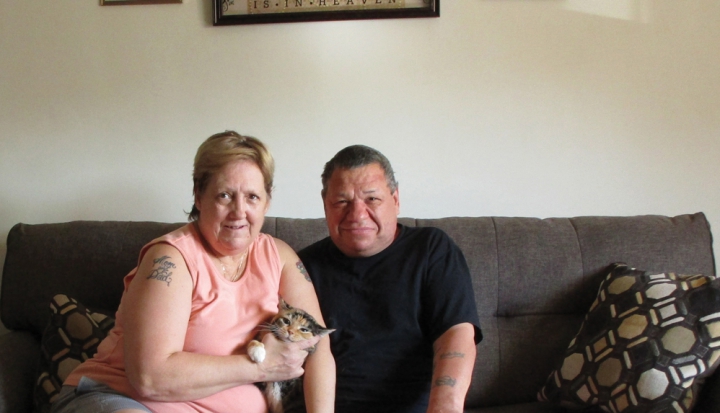The national headlines in 2015 were bold and attention grabbing. “Utah is winning the war on chronic homelessness with ‘Housing First’ program,” proclaimed the Los Angeles Times. “The surprisingly simple way Utah solved chronic homelessness and saved millions,” enticed the Washington Post. Mother Jones framed Utah’s story as, “The shockingly simple, surprisingly cost-effective way to end homelessness.”
It sounded easy: By providing housing to the chronically homeless, Utah had drastically reduced the number of people living on the streets. While the headlines praised this seemingly radical idea, housing first—providing people places to live without any preconditions—is not a new concept. And the 91 percent reduction in Utah’s chronically homeless population, while eye-catching, did not paint a complete picture.
“Right now, within a block of our offices, there’s close to 1,000 people living on the streets, and the nighttime shelter across the street is full. There’s definitely not the feeling that we’ve solved homelessness by any means,” says Matthew Melville, director of homeless services for Catholic Community Services (CCS) of Utah, based in Salt Lake City.
CCS services include the St. Vincent de Paul Dining Hall and Weigand Homeless Resource Center, which provide meals and daytime shelter to Salt Lake’s homeless population. “At the Weigand Center we’ll see close to 400 people a day in the summertime, and in the wintertime we’ll see sometimes close to 600 people on cold, snowy days,” Melville says.
Housing First has a simple name, but it is a complex program reliant on a large number of partnerships. And although it is an efficient and cost-effective way to move the chronically homeless into permanent supportive housing, it’s just one part of wider systemic changes needed to reduce and ultimately eliminate homelessness.
“The state did prioritize funding housing for people, which has definitely helped drop the numbers of homeless a lot,” Melville says. “But here we look out our door and still see people coming in by the hundreds, and we know the work isn’t done. We’ve made a lot of headway, but there’s still a lot of work to do.”
A simple solution
Sam Tsemberis, founder of Pathways Housing First Institute, which provides training for housing first programs, is considered the father of housing first. He admits, however, that he didn’t have that intention when, in 1992, he first began to reach out to help those who had been homeless for a long time and who were struggling with mental illness or addiction.
“It was never called ‘housing first’ when I first developed it,” Tsemberis says. “We were thinking that if we could only get these people medical or psychiatric attention, we could help them get their lives together.”
As Tsemberis began his outreach, he found that people were looking for a different, though in hindsight more obvious, answer. “The people who we engaged were very articulate and said the most obvious thing we didn’t expect them to say: ‘Isn’t it obvious? I need a place to stay,’ ” Tsemberis says. “They wanted a place of their own. The most frequently requested type of assistance was a simple place of their own like they had before they were homeless.”
The biggest barrier for most people to achieving this was the fact that most housing programs came with strings attached. “All the programs that we approached were immediately inaccessible for people because most required sobriety, treatment, compliance with certain rules, or contribution of a high percentage of disability income, if you had it,” explains Tsemberis. “There were so many rules that people either did not agree with or could not comply with. The only way we could figure out to get them housed was to do it ourselves—to rent an apartment from a landlord for them. Of course they needed many other things once they were housed, and that’s what the program is about. It provides housing first and then ongoing home visits for support, ensuring the well-being of the client.”
Autonomy is one of the unique aspects of housing first, as more often than not people have very little say in the services or programs in which they participate. “The way social service programs were developed basically said, ‘Here’s the deal: You do this, come in and go out at this time, these are the meals, take it or leave it,’ ” Tsemberis says. “Housing first says, ‘How can we put together services, including housing, in a way that’s meaningful to you?’ ”
Once housed, people have different needs, whether getting to a court date, paying bills, contacting family members, or seeing a doctor. With housing first, the individual controls what gets addressed when. “It doesn’t matter what the particular thing is that the person wants,” says Tsemberis. “They tell us in a way that makes sense to them, in the priority that makes sense to them. They are in the driver’s seat.”
Housing first in action
Downtown Emergency Service Center (DESC) in Seattle is a large multiservice provider that offers emergency shelter, clinical treatment, and more than 1,000 units of permanent supportive housing throughout the city. Executive Director Daniel Malone points out that housing first was not introduced without controversy. “By and large these reactions were rooted in the idea that the individuals were unreliable to handle their own affairs or make good decisions for themselves,” he says.
Criticism generally held that you were setting people up for failure if you didn’t make sure they had made progress toward stabilizing their lives ahead of receiving housing. Others questioned if it made sense to give limited resources to those who didn’t show they were willing to meet their end of a supposed social contract. “The housing first proponents saw something different, which is that people in fact want to do better and improve their circumstances,” Malone says.
The positive results were immediately apparent on an individual level for participants in housing first. “People used alcohol and other substances less. People dramatically decreased their use of crisis services in the health care and criminal justice systems,” Malone says. “These outcomes really surprised a lot of people who predicted problems.” Some studies have shown that housing retention rates can reach as high as 98 percent for those in permanent supportive housing.
Besides improving lives, housing first also reduces dependence on crisis services such as emergency medical assistance. According to the National Alliance to End Homelessness, over the course of two years of housing someone in a housing first program, you might see emergency services savings of more than $31,000 per person.
“Housing first ends up being a less expensive alternative to shelters because people don’t end up in the hospital or in jail as often,” says Sandra Romeo, vice president of housing services at Pathways to Housing PA (PTHPA), based in Philadelphia. PTHPA boasts an 85-percent housing retention rate thanks to a finely tuned housing first program. The city identifies prospective clients and provides referrals to PTHPA.
“You don’t have to have income, you don’t have to agree to treatment, you don’t have to take your medication, you don’t have to be clean and sober,” says Romeo. “We will take somebody and put them right into an apartment. From there we work to engage them to try to get supportive services, but it’s not a requirement.” Teams of service coordinators, nurses, drug and alcohol specialists, psychiatrists, and more are deployed to help people with wraparound services to help make sure they can stay housed and get the care they need.
PTHPA partners with landlords throughout the community to sign leases and in turn sign occupancy agreements with the tenant. Tenants contribute 30 percent of whatever income they have—if it’s nothing, 30 percent of zero is zero. The cost is subsidized through funding from the Department of Housing and Urban Development (HUD).
“When our housing director first thought about this, he thought he would never find a landlord to rent to us. But we have a stack of landlords asking us to please rent more apartments from them,” Romeo says.
Digging deeper
From 2013 to 2014 chronic homelessness decreased nationally by 2.5 percent, while permanent supportive housing efforts increased by 5.6 percent. So with the proven success of housing first programs, federal funding has shifted away from emergency and transitional solutions toward permanent supportive housing.
But although the chronically homeless make up only about 15 percent of all people experiencing homelessness, the vast majority of federal funding goes toward solutions geared toward this population. In 2016, 73 percent of HUD funding for continuum of care programs went to permanent supportive housing; transitional housing received only 6 percent and supportive services only 2 percent.
“Most people who experience homelessness or who are living in poverty don’t need the level of services typically supplied with housing first intervention,” says Malone of DESC. Melville sees the same at CCS in Utah. Although it serves hundreds daily, the average length of time an individual uses CCS services is about 90 days.
Another housing first solution, called rapid rehousing, exists for the type of people who may be experiencing homelessness as the result of job loss or an unanticipated medical expense, for example. These people may not need long-term supportive services. With rapid rehousing, individuals and families receive short-term assistance.
By gaining assistance with finding housing, making rent payments, or case management, people can quickly obtain housing and reach self-sufficiency. (In 2016 rapid rehousing programs received the second highest portion of HUD continuum of care funding—13 percent—second only to permanent supportive housing.)
To Malone, the argument against housing first because it isn’t a solution for everyone doesn’t hold much water. “I don’t think it’s a reasonable proposition to say either we put money into housing first or we put it in other programs. That is just pitting one disadvantaged group against another, and that’s a losing strategy,” Malone says. “Arguing that resources going to permanent supportive housing leave behind those who need other solutions is not an argument against housing first. That’s an argument that there aren’t enough resources in the system to address people with various kinds of needs. Housing first, as a downstream intervention, isn’t really capable of stopping society from throwing other people into homelessness.”
One piece of the puzzle
What the headlines from Utah demonstrated to Tsemberis was that if you focus on an existing homeless population and spend the money to fix it, you’ll have a more efficient system for a short period of time. But without addressing the underlying causes of homelessness, you won’t be doing anything besides helping out a fixed number of people who were chronically homeless at that one point in time.
“To stop people from becoming homeless, we’ve got to talk about rising housing prices, income disparity, the minimum wage not being a living wage, racism, unemployment, the lack of a national health plan, poor access to treatment for addiction, and stigma about mental health treatment,” Tsemberis says. These kinds of determinants, regardless of the attention or funding behind housing first solutions, still create homelessness at a steady rate. “You can be ingenious in addressing the current pool of homeless people, but the minute you’ve taken a few buckets and emptied out the pool, that pool will be filled again because the structural determinants have not been addressed,” he says.
Melville also says more needs to be done to address the underlying causes. “Housing first is a great program, but we shouldn’t focus exclusively on it because it’s not for everybody,” he says.
One thing CCS of Utah does is focus on employment for those who are capable of working. “We have monthly job fairs with our employment specialists to help people find jobs to save up for rent while staying at the shelter,” Melville says. “The library gives computer classes to our clients, since a lot of times just filling out an application online can be a daunting task. We try to create as much as possible under one roof, because people’s time is precious, and we want to make their stay here as short as possible so they can get into housing.”
The biggest issue Melville sees facing Salt Lake City is a lack of affordable housing. “We need to do a lot more to get more affordable housing and subsidized housing in the Salt Lake City market,” he says. “Our city’s population keeps growing, and the demand is for higher-rent condos and apartments. There’s not much out there for our low-income friends, who are getting priced out of their apartments.”
Looking ahead
For Tsemberis, investing in affordable housing is an important first step toward the ultimate goal of eliminating the systemic problems that cause homelessness. “We want to be in a place where you don’t need housing first because you take care of the structural problems,” he says. “So why don’t we invest in building actual affordable housing and addressing other issues that are creating the problems?”
It’s an important question facing service providers, who must decide whether to address long-term or short-term solutions to poverty and homelessness as they evaluate how to spend limited funding. “We find ourselves in this constant debate,” Malone says of DESC, which provides shelter and survival services, as well as permanent housing. “Should we apply our resources just to housing, because those are the permanent solutions, or should we apply them to emergency solutions to deal with the crises on the street today? There’s not a particularly easy answer to that question.”
Complicating this question is uncertainty about the federal budget and what resources may be available in the future. “If we don’t have enough resources to do everything we need to do, it’s a real dilemma around where we actually should use them,” Malone says.
An important step forward he sees is to change the conversation about housing. “We have to find a way to change society’s perspective on what it means to us for people to have housing,” Malone says. “We don’t have anything resembling a right to housing that we collectively have decided that everyone should be entitled to. As a society we ought to be able to get our minds around that housing is just a basic need everybody has. Why would we accept that some people are just too poor to be able to have it?”
And for Melville, the work will continue in Utah. “Even one homeless person is one too many. We want people to know we’re still here, we haven’t solved the issue, we’re still working on it every day, and it’s not going to get solved overnight,” Melville says. “We want people to know we’re looking for solutions. We’re always looking for innovative ways to reach out to people.”
This article also appears in the February 2018 issue of U.S. Catholic (Vol. 83, No. 2, pages 12–17).
Image: Courtesy of Sandra Romeo at Pathways to Housing PA














Add comment